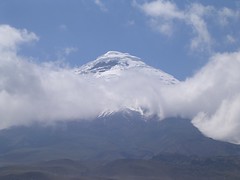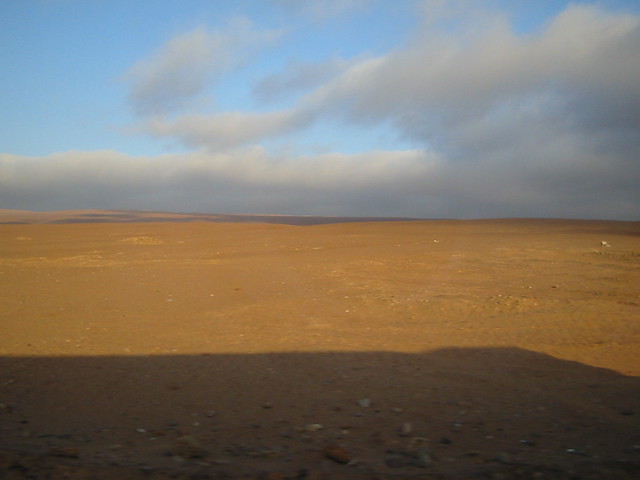The Cotopaxi volcano wakes up after nearly 100 years, and after a period of continuous seismic activity on its slopes, began erupting a plume of ash and gas 5 km high on 15th August 2015. The Cotopaxi is a volcano of the Andean belt or pacific ring fire, it is 5897 meters high and only 50 kilometers away from Quito, the capital of Ecuador.
Baños hot springs
Baños is a small city which rises in a flat piece of land, where the Andean valleys begin their tortuous descent towards the Amazon basin… we get there leaving the Pan-American highway near Ambato, city center of one of the most colored carnivals of Latin America (“fiestas de las flores y las frutas”). In the subtropical climate of Baños meet all the forces of nature: the Tungurahua volcano that dominate the village and it’s currently in eruption, frequent earthquakes, some impressive cascades and the clouds that incessantly thickens on the flanks of the mountains. In reason, the inhabitants of Baños talk with emphasis about the last eruption of the Tungurahua (August 2006), when part of the pueblo was destroyed. However, several Ecuadorian tourists come here, attracted by the hot springs of warm and sulfurous water; we also find a pleasant place, where we have a good time before the breathtaking descent towards the Amazon river basin.
Cotopaxi National Park
Exactly in front of the bridge which is the entrance gate to the city of Latacunga, a young boy tell us to go up on its rickety bus. It’s early in the morning, we begin the travel towards the covered by snow and perfectly conical top of the Cotopaxi volcano. The road rises inexorably: three, four, five thousand meters, the landscape becomes even more impressive. The silence owns these windy places, lived by the only animals have been able to adapt to the hard Andean climate (alpacas, condors, pumas, wild horses). For a moment we dream to go up till the top of the Cotopaxi crater to dominate an exterminated horizon, but climbing the highest active volcano of the world is not an adventure that could be organized in five minutes… some horses, pride of their freedom, follow us suspiciously while we walk around the Limpiopungo lagoon. Three big condors of the Andes caress the lost in clouds peak of the Rumiñahui volcano, where a warm and blinding sun (the god Inti in the Incaic culture, indeed) tries to open itself the way in the foggy cover.
On the way back we pass near Saquisili, a village which is center of one of the most colored Ecuadorian markets, every Thursday.
Arequipa and Juanita, Inca ice maiden
Arequipa, a jewel set in the wide valleys of southern Peru Andean plateau, is known from the Peruvians as the white city. A quiet and hospitable city, where to acclimatize before the rise in remote parts of the Andes. The drown tops of three volcanoes brush the city, the misti (gentleman, with its perfectly conical shape), the Chachani (beloved) and Picchu Picchu (high high) in the Quechua language. In the basement at the Convent of Santa Catalina, in an eternal embrace, lies the mummy of a girl (nicknamed Juanita, or Inca ice maiden) sacrificed in a ritual at Mount Ampato by the Incas 500 years ago. The encounter with a “viejo loco”, as he introduced himself, gives us a glimpse of Latin America, sitting in a tiny square of Arequipa, under the shade of some orange trees in bloom, we begin a long conversation on the life and traditions of the Andes and Arequipa. He traveled widely as a young man, being a street artist, and his memories are still bright. We discussed the magical combination of moods, colors, flavors, music and experiences that brings the traveler in his pilgrimage. In Arequipa it’s easy to meet lots of people, also because the climate is very hospitable. We receive an invitation to the home of a boy, out of town. We get to know their grandparents, who take care of alfalfa and corn fields and prepare for us a rich and delicious lunch accompanied by abundant traditional chicha, a fermented drink produced from corn. Sitting around the fire we eat and listen with interest the story of their lives, amid joys and sacrifices. After lunch, we learn the basics needed to play the Quena, the typical flute used in Andean music.
Andean highlands, desert and telescopes
Beyond the Valley of Azapa endless stretch the Andean highlands, where the desert becomes a spectacular red livery. It seems to land on Mars. On a fifty years old chevrolet car, we follow a faint-track in this inhospitable land in the direction of Putre, the town that serves as a starting point for visits to Lauca National Park and the ascent to the volcano Taapaca. In this portion of the plateau, the nature shows all its magnificence and hardness. Scattered groups of vicunas escape hopping as soon as they hear the noise of the car approaching. The wind whips the faces of the natives who, consumed by the sun and altitude, are covered in a last attempt at defense. The link between earth and sky has always been part of the cosmogony of the Andean peoples, inevitable is the attraction to these mountains and the altitude of the plateau caused to civilizations that lived in these places. Still this yearning for the infinite is well represented by the presence on the andean highlands of several research centers using large telescopes for the observation of space and celestial bodies. Examples are the Panaral Observatory, Cerro Pachon and Las Campanans observatory. In exceptional years, the rare rains return to wet lands of the arid Atacama desert, causing an explosion of nature to appear in the form of endless expanse of green lawns and bright flowers, of which many insects feast insatiable. They perfectly know that the desert gives little time to abundance.




